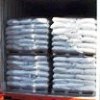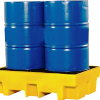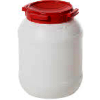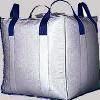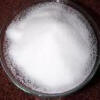Sodium Propionate Manufacturers Suppliers Exporters USP BP IP FCC, India
Anmol Chemicals are manufacturers of Specialty Chemicals and Pharmaceutical Excipients, in India. Anmol Chemicals Group has manufacturing facilities spread across India, representatives in Houston Chicago USA and toll manufacturers in China. We make IP, BP, USP, Ph Eur, FCC or Food Grade, ACS, AR or Analytical Reagent Grade, LR or Laboratory Reagent Grade and Pure Grades of various chemicals. All our items are analyzed to meet the required standards.
Our manufacturing facility is FDA GMP approved and ISO-9001, ISO 14000, OHSAS 18000, ISO 22000, FSSAI HACCP certified. We are offering products manufactured as per Kosher and Halal approved method. We are pre-registered with "Reach" for export to European countries.
CAS No.: Anhydrous [137-40-6], Molecular Weight: 96.1, Chemical Formula: C3H5NaO2
We offer Sodium Propionate Commercial Pure and Pharmacopoeia Grades
Sodium Propionate Commercial Food Grade & Pure
Sodium Propionate
CH3CH2COONa
C3H5NaO2 Formula wt 96.06
INS: 281 CAS: [137-40-6]
DESCRIPTION
Sodium Propionate occurs as white or colorless, transparent crystals or as a granular, crystalline powder. It is hygroscopic in moist air. One gram is soluble in about
1 mL of water at 25°, in about 0.65 mL of boiling water, and in about 24 mL of alcohol. The pH of a 1:10 aqueous solution is between 8.0 and 10.5.
Function: Preservative; mold inhibitor.
REQUIREMENTS
Identification:
A. A 1:20 aqueous solution gives positive tests for Sodium.
B. Upon ignition, a sample yields an alkaline residue that effervesces with acids.
C. Warm a small sample with sulfuric acid. Propionic acid, recognized by its odor, evolves.
Assay: Not less than 99.0% and not more than 100.5% of C3H5NaO2 after drying.
Alkalinity (as Na2CO3): Passes test (about 0.15%).
Iron: Not more than 0.003%.
Lead: Not more than 2 mg/kg.
Water: Not more than 1%.
Sodium Propionate BP British Pharmacopoeia
C3H5NaO2
96.1 -- 137-40-6
Action and use
Antifungal
DEFINITION
Sodium propionate
Content
99.0 per cent to 101.0 per cent Sodium propionate (dried substance).
CHARACTERS
Appearance
Colourless crystals or, white or almost white powder, slightly hygroscopic.
Solubility
Freely soluble in water, sparingly soluble in alcohol, practically insoluble in methylene chloride.
IDENTIFICATION
First identification A, D.
Second identification B, C, D.
A. Infrared absorption spectrophotometry.
Comparison reference spectrum of sodium propionate.
B. Dissolve 0.1 g in a mixture of 2 ml of copper sulphate solution and 2 ml of methylene chloride. Shake vigorously and allow to stand. Both the upper and the lower
layer show a blue colour.
C. To 5 ml of solution S add 2 ml of 0.1 M silver nitrate. A white precipitate is formed.
D. Solution S gives reaction of sodium.
TESTS
Solution S
Dissolve 10 g Sodium propionate in carbon dioxide-free water prepared from distilled water and dilute to 100 ml with the same solvent.
Appearance of solution
Solution S is clear and colourless.
pH
7.8 to 9.2
Dilute 1 ml of solution S to 5 ml with water.
Related substances
Liquid chromatography.
Test solution: Dissolve 0.250 g of the substance to be examined in water and dilute to 100 ml with the same solvent.
Reference solution (a) Dissolve 10 mg of the substance to be examined and 10 mg of sodium acetate in water and dilute to 100 ml with the same solvent.
Reference solution (b) Dilute 1.0 ml of the test solution to 100 ml with water.
Column: ı
ı size: l= 0.25 m, Ĝ = 4.6 mm;
ı stationary phase: octadecylsilyl silica gel for chromatography (5μm).
Mobile phase Dilute 1 ml of phosphoric acid R to 1000 ml with water.
Flow rateı1 ml/min.
Detection Spectrophotometer at 210 nm.
Injectionı20 μl.
System suitability Reference solution (a):
ı resolution: minimum 5 between the peaks due to sodium acetate and sodium propionate.
Limits:
ı any impurity: not more than 0.1 times the area of the principal peak in the chromatogram obtained with reference solution (b) (0.1 per cent);
ı total: not more than half the area of the principal peak in the chromatogram obtained with reference solution (b) (0.5 per cent);
ı disregard limit: 0.05 times the area of the principal peak in the chromatogram obtained with reference solution (b) (0.05 per cent).
Readily oxidizable substances
In a ground-glass-stoppered conical flask introduce 10 g of the substance ( Sodium propionate.) to be examined.
Add 100 ml of water R and stir to dissolve. Add 25 ml of sodium hypobromite solution and 10 ml of a 200 g/l solution of sodium acetate, stopper the flask and allow to
stand for 15 min. Add 10 ml of potassium iodide solution and 20 ml of hydrochloric acid while cooling.
Titrate with 0.2 M sodium thiosulphate, adding 2 ml of starch solution R towards the end of the titration. Carry out a blank titration. The difference between the
volumes used in the 2 titrations is not greater than 2.2 ml.
Iron
Maximum 10 ppm.
10 ml of solution S complies with the limit test for iron.
Heavy metals
Maximum 10 ppm.
12 ml of solution S complies with limit test A. Prepare the standard using lead standard solution (1 ppm Pb).
Loss on drying
Maximum 0.5 per cent, determined on 1.000 g by heating in an oven at 105C for 3 h.
ASSAY
Dissolve 80.0 mg Sodium propionate in 30 ml of anhydrous acetic acid R. Titrate with 0.1 M perchloric acid, determining the end-point potentiometrically.
1 ml of 0.1 M perchloric acid is equivalent to 9.61 mg of C3H5NaO2.
Sodium Propionate FCC Food Grade as per Food Chemical Codex
Sodium Propionate
CH3CH2COONa
C3H5NaO2 Formula wt 96.06
INS: 281 CAS: [137-40-6]
DESCRIPTION
Sodium Propionate occurs as white or colorless, transparent crystals or as a granular, crystalline powder. It is hygroscopic in moist air. One gram is soluble in
about 1 mL of water at 25°, in about 0.65 mL of boiling water, and in about 24 mL of alcohol. The pH of a 1:10 aqueous solution is between 8.0 and 10.5.
Function: Preservative; mold inhibitor.
REQUIREMENTS
Identification:
A. A 1:20 aqueous solution gives positive tests for Sodium.
B. Upon ignition, a sample yields an alkaline residue that effervesces with acids.
C. Warm a small sample with sulfuric acid. Propionic acid, recognized by its odor, evolves.
Assay: Not less than 99.0% and not more than 100.5% of C3H5NaO2 after drying.
Alkalinity (as Na2CO3): Passes test (about 0.15%).
Iron: Not more than 0.003%.
Lead: Not more than 2 mg/kg.
Water: Not more than 1%.
Sodium Propionate NF USP
Sodium Propionate
C3H5NaO2·xH2O
Propanoic acid, sodium salt, hydrate.
Sodium propionate hydrate [6700-17-0]
Anhydrous 96.06 [137-40-6]
Sodium Propionate, dried at 105 for 2 hours, contains not less than 99.0 percent and not more than 100.5 percent of C3H5NaO2.
Identification
A: Infrared Absorption 197K , on un-dried specimen.
B: A solution (1 in 20) responds to the tests for Sodium.
Alkalinity Dissolve 2.0 g in 20 mL of water, and add phenolphthalein TS: if a pink color is produced, it is discharged by 0.60 mL of 0.10 N sulfuric acid.
Water: not more than 1.0%.
Heavy metals Dissolve 2 g in 1 mL of 1 N acetic acid and sufficient water to make 25 mL: the limit is 0.001%.
Organic volatile impurities: meets the requirements.
(Official until July 1, 2007)
Assay Dissolve about 200 mg of Sodium Propionate, previously dried at 105 for 2 hours and accurately weighed, in 50 mL of glacial acetic acid. Add 1 drop of
crystal violet TS, and titrate with 0.1 N perchloric acid VS to a green endpoint. Perform a blank determination, and make any necessary correction. Each mL of 0.1 N
perchloric acid is equivalent to 9.606 mg of C3H5NaO2.
Manufacturers
ANMOL CHEMICALS
S-8, SARIFA MANSION, 2ND PRINCIPAL SHAIKH HASAN MARG, MUMBAI 400009, INDIA
TEL: (OFF) 91-22-23726950, 23774610, 23723564. FAX: 91-22-23728264
e-mail: info@anmol.org
Copyright and Usual Disclaimer is Applicable
Exporters to USA, UAE, Europe, South Africa, Tanzania, Kenya, Egypt, Turkey, Nigeria, Uganda, Brazil, Chile, Argentina, Dubai etc.
Representatives in New York, Houston - Texas, Chicago - Illinois, Los Angeles.
Fast Selling IP BP USP ACS FCC Food Grades of Chemicals by Anmol Chemicals
Aluminum Chloride ---------- Ammonium Sulfate ----- Ammonium Persulfate
Aluminum Potassium Sulfate - Ammonium Chloride ---- Ammonium Bicarbonate
Ammonium Carbonate --------- Benzyl Alcohol ------- Boric Acid
Benzoic Acid --------------- Borax; Sodium Borate - Calcium Chloride
Calcium Hydroxide ---------- Calcium Acetate ------ Calcium Butyrate
Calcium Lactobionate ------- Calcium Levulinate --- Calcium Saccharate
Carbamide Peroxide --------- Citric Acid ---------- Calcium Phosphate
Calcium Oxide -------------- Calcium Sulfate ------ Chromic Chloride
Cupric Chloride ------------
Ferric Chloride ------------ Ferric Nitrate ------- Fumaric Acid
Gentian Violet ------------- Glacial Acetic Acid
Lactobionic Acid ----------- Magnesium Butyrate
Magnesium Oxide ------------ Magnesium Chloride --- Magnesium Sulfate
Malic Acid ----------------- Maleic Acid ---------- Manganese Chloride
Manganese Sulfate ---------- Methylene Blue ------- Oleic Acid
Octyldodecanol -------------
Propylene Carbonate -------- Potassium Acetate ---- Potassium Carbonate
Potassium Hydroxide -------- Potassium Chloride --- Potassium Phosphate
Potassium Bitartrate ------- Propylene Carbonate -- Selenious acid
Sodium Molybdate ----------- Sodium Perborate ----- Sodium Phosphate
Sodium Propionate ---------- Sodium Acetate ------- Sodium Bicarbonate
Sodium Hydroxide ----------- Sodium Chloride ------ Sodium Thiosulfate
Sodium Selenite ------------ Urea ----------------- Zinc Chloride
Other Best Selling Products
Ammonium Bromide ----------- Ammonium Phosphate --- Barium Chloride
Butylated Hydroxyanisole --- Butylated Hydroxytoluene
Calcium Nitrate Nitrite ---- Calcium Propionate --- Copper Sulfate
Ceric Ammonium Nitrate ----- Cinnamaldehyde ------- Isatoic Anhydride
Directly Compressible Calcium Carbonate ----------- Encapsulated Citric Acid
Encapsulated Fumaric Acid -- Encapsulated Sodium Bicarbonate -
Encapsulated Sorbic Acid
Potassium Bromide ---------- Potassium Iodide ----- Potassium Nitrate Nitrite
Sodium Bromate ------------- Skatole -------------- Sodium Butyrate
Sodium Nitrite & Nitrate --- Sodium Bromide ------- Sodium Diacetate
Sodium Formaldehyde Bisulfite Strontium Chloride -- Stannous Chloride
TBHQ Tertiary Butylhydroquinone







